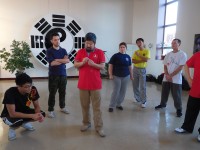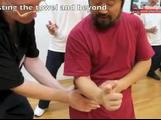 Do the form. A lot. Do it so much you never have to think about the next move, until all the movements and transitions are fluent. Only then can you work on a specific principle comfortably enough to improve.
Do the form. A lot. Do it so much you never have to think about the next move, until all the movements and transitions are fluent. Only then can you work on a specific principle comfortably enough to improve.- Finish each move (in the form) and keep going. Keep going into the next one.
- We have to be capable of anchoring power on the outside, just as we have to be capable of anchoring power on the inside. IE: body movement that anchors on the hand (hand doesn’t move), and hand movement that anchors on the body (centre line doesn’t move). Maintain consistent power on the outside while the inside stays mobile.
 Don’t push – trace. Once the opponent starts engaging, you’ve already reached the maximum ‘fight’ required. From there, maintain those contact points (walls) and put pressure where they are empty. Continue putting up walls until they push themselves out or fall down.
Don’t push – trace. Once the opponent starts engaging, you’ve already reached the maximum ‘fight’ required. From there, maintain those contact points (walls) and put pressure where they are empty. Continue putting up walls until they push themselves out or fall down.- Pushing has to be a matter of yin and yang. Both the physical space occupied, and the empty space which is unoccupied must be considered. As the point of contact pushes, use something else (ie: waist) to take up the negative space. This prevents them from moving or escaping into that free space as you have already taken it.
- Strategy – don’t fight the fight. Your fight must invade their territory. Never let them enter your space. You must already be on them or behind them.
- If you don’t switch back, you don’t complete the circle.
- Make the forearm one piece – normally it is inconsistent. The consistency is created by a stretch, or a push (compression). This consistency is peng energy.
- Overall, the size of the power is not important. It is how consistent it is. Consistency is trained through the principles. And by its nature it is indirect. Stretching and compression are the same thing, only the point of reference has changed.
- Principle is called gong fu. Ability is called technique. Ability can be lost (atrophied), but principle cannot. That’s why older people can still teach – because the student can still feel the principle.
- There can be no action, only parts that can be acted upon.



{ 2 comments… read them below or add one }
Great notes Brennan. Thank for sharing.
I agree with Harshil, these are great notes. The discussion of don’t push and don’t fight are a new level of clarity for me. Of course we’ve heard these general instructions many times before. This particular discussion is really connecting for me now. I guess it’s not really that the instructions are more clear, but that I am more ready to understand them.